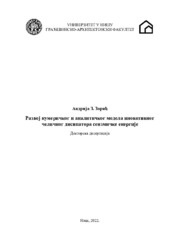| dc.contributor.advisor | Trajković-Milenković, Marina | |
| dc.contributor.other | Zlatkov, Dragan | |
| dc.contributor.other | Petrović, Žarko | |
| dc.contributor.other | Mladenović, Biljana | |
| dc.contributor.other | Đorić, Stanko | |
| dc.creator | Zorić, Andrija | |
| dc.date.accessioned | 2023-09-06T14:47:54Z | |
| dc.date.available | 2023-09-06T14:47:54Z | |
| dc.date.issued | 2022 | |
| dc.identifier.uri | http://eteze.ni.ac.rs/application/showtheses?thesesId=8595 | |
| dc.identifier.uri | https://fedorani.ni.ac.rs/fedora/get/o:1882/bdef:Content/download | |
| dc.identifier.uri | https://plus.cobiss.net/cobiss/sr/sr/bib/112733705 | |
| dc.identifier.uri | https://nardus.mpn.gov.rs/handle/123456789/21694 | |
| dc.description.abstract | Performance of an innovative steel dissipator of seismic energy applied
in the passive vibration control system of buildings has been analysed in
the dissertation. When determining the performance, the geometric
characteristics of the energy dissipator and the physical and mechanical
characteristics of the steel material have been varied. The analyses were
performed on the sophisticated numerical computational models
developed using the Finite Element Method. The numerical model was
validated against the available experimental test results of the energy
dissipator components. It has been proven that the innovative steel
dissipator of seismic energy has significant nonlinear hysteretic
performance, whereby it is possible to achieve significant seismic energy
dissipation. Based on the analyses, conclusions were drawn regarding the
influence of the geometric and material parameters on the performance
of energy dissipator and recommendations for its application in
engineering practice were given. In order to obtain the response of energy
dissipator to monotonically increasing load an analytical model was
developed. This model is also used to define the parameters for describing
the idealized response to monotonically increasing as well as to cyclic
loading, which is the starting point in the analysis of seismically isolated
buildings using the proposed energy dissipator. Using the example of an
isolated structure, with the direct dynamic analysis in time domain, the
efficiency of energy dissipator was confirmed in terms of reducing
seismic forces and relative interstorey drift ratio during real and artificial
earthquakes accelerogram in relation to the case of rigid foundation of the
structure. | en |
| dc.format | application/pdf | |
| dc.language | sr | |
| dc.publisher | Универзитет у Нишу, Грађевинско-архитектонски факултет | sr |
| dc.rights | openAccess | en |
| dc.rights.uri | https://creativecommons.org/licenses/by-nc-nd/4.0/ | |
| dc.source | Универзитет у Нишу | sr |
| dc.subject | čelični disipator energije | sr |
| dc.subject | steel damper | en |
| dc.subject | passive vibration control | en |
| dc.subject | hysteresis behaviour | en |
| dc.subject | cyclic load | en |
| dc.subject | experimental test | en |
| dc.subject | finite element method | en |
| dc.subject | pasivna kontrola vibracija | sr |
| dc.subject | histerezisno ponašanje | sr |
| dc.subject | ciklično opterećenje | sr |
| dc.subject | eksperimentalno ispitivanje | sr |
| dc.subject | metod konačnih elemenata | sr |
| dc.title | Razvoj numeričkog i analitičkog modela inovativnog čeličnog disipatora seizmičke energije | sr |
| dc.type | doctoralThesis | |
| dc.rights.license | BY-NC-ND | |
| dc.identifier.fulltext | http://nardus.mpn.gov.rs/bitstream/id/151962/Disertacija.pdf | |
| dc.identifier.fulltext | http://nardus.mpn.gov.rs/bitstream/id/155704/Andrija_Z_Zoric.pdf | |
| dc.identifier.rcub | https://hdl.handle.net/21.15107/rcub_nardus_21694 | |



